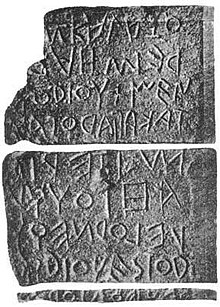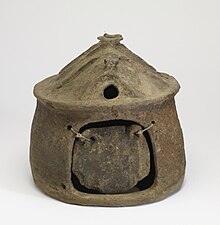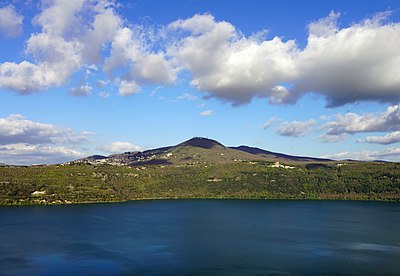Latins (Italic tribe)
After the fall of the Roman monarchy around 500 BC, there appears to have been a century of military alliance between Rome and the other Latin states to confront the threat posed to all Latium by raiding by the surrounding Italic mountain tribes, especially the Volsci and Aequi.
This system progressively broke down after roughly 390 BC, when Rome's aggressive expansionism led to conflict with other Latin states, both individually and collectively.
The name Latium has been suggested to derive from the Latin word latus ("wide, broad"), referring, by extension, to the plains of the region (in contrast to the mainly-mountainous Italian Peninsula).
Most scholars consider that Etruscan is a pre-IE survival, a Paleo-European language[23] part of an older European linguistic substratum,[3] spoken long before the arrival of proto Indo-European speakers.
[26] The archaeological evidence available from Iron Age Etruria shows no sign of any invasion, migration, or arrival of small immigrant-elites from the Eastern Mediterranean who may have imposed their language.
[28][29][30] A 2019 Stanford genetic study, which has analyzed the autosomal DNA of Iron Age samples from the areas around Rome, has concluded that Etruscans were similar to the Latins from Latium vetus.
[31] According to British archeologist Phil Perkins, "there are indications that the evidence of DNA can support the theory that Etruscan people are autochthonous in central Italy".
[34] Written in a primitive form of Archaic Latin, it indicates that the Romans remained Latin-speakers in the period when some historians have suggested that Rome had become "Etruscanised" in both language and culture.
Initially, the Latin immigrants into Latium were probably concentrated in the low hills that extend from the central Apennine range into the coastal plain (much of which was then marshy and malarial, and thus uninhabitable).
[40] They represent the typical single-roomed hovels of contemporary peasants, which were made from simple, readily available materials: wattle-and-daub walls and straw roofs supported by wooden posts.
[41] The most famous exemplar was the Casa Romuli ("Hut of Romulus") on the southern slope of the Palatine Hill, supposedly built by the legendary founder of Rome with his own hands and which reportedly survived until the time of emperor Augustus (ruled 30 BC - AD 14).
In the historical era, the same socio-cultural lifestyle was maintained, in the same regions, by peoples descended from the Proto-Indo-Europeans (PIEs) known to the Greco-Romans as Scythians, Sarmatians and Alans, whose languages belonged to the Iranian branch of IE.
Their most important common tribal event was the four-day Latiar or Feriae Latinae ("Latin Festival"), held each winter on the sacred mons Albanus (Monte Cavo, Alban Hills, SE of Rome), an extinct volcano.
The historian Livy, writing around AD 20, ascribed Rome's disastrous defeat by the Carthaginian general Hannibal at the Battle of Lake Trasimene in 217 BC to the impiety of the consul Gaius Flaminius, who, in his eagerness to join his army at its assembly-point of Arretium, failed to attend the Latin Festival.
This may be the sacred grove to Diana which a fragment of Cato's Origines recorded dedicated, probably c. 500 BC, by various Latin communities under the leadership of the dictator of Tusculum, Egerius Baebius.
[50] Cornell argues that the temple of Diana reportedly founded by the Roman king Servius Tullius on the Aventine hill at Rome was also a common Latin shrine, as it was built outside the pomerium or City boundary.
It was centred on the figure of Aeneas, a supposed Trojan survivor of the destruction of Troy by the Achaean Greeks, as related in the poet Homer's epic the Iliad (composed c. 800 BC).
It also provided a rationale (as poetic revenge for the destruction of Troy) for Rome's hostilities against, and eventual subjugation of, the Greek cities of southern Italy, especially Taras (mod.
[53] The figure of Aeneas as portrayed in the Iliad lent itself to his adoption as the Roman "Abraham": a mighty warrior of (minor) royal blood who personally slew 28 Achaeans in the war, he was twice saved from certain death by the gods, implying that he had a great destiny to fulfil.
The Trojan hero Aeneas and his men fled by sea after the capture and sack of their city, Troy, by the Greeks in 1184 BC, according to one ancient calculation.
[56] Under a later king Tullus Hostilius (traditional reign-dates 673–642 BC), the Romans razed Alba Longa to the ground and resettled its inhabitants on the mons Caelius (Caelian Hill) in Rome.
[57] Indeed, the Bulgarian linguist Vladimir Georgiev argued that the original Etruscans were in fact descendants of those Trojan refugees and that the Aeneas legend has a historical basis.
The genealogy's dubious nature is shown by the fact that it ascribes the 14 Alban kings an average reign of 30 years' duration, an implausibly high figure.
Nevertheless, Cornell argues that "Romulus probably never existed... His biography is a complex mixture of legend and folk-tale, interspersed with antiquarian speculation and political propaganda".
The Romans apparently prevailed, scoring a notable victory over the Latin forces at Lake Regillus sometime in the period 499-493 BC (the exact year is disputed among scholars).
The impetus to form such an alliance was probably provided by the acute insecurity caused by a phase of migration and invasion of the lowland areas by Italic mountain tribes in the period after 500 BC.
The Latins faced repeated incursions by the Hernici, Aequi and Volsci, whose territories surrounded Latium Vetus on its eastern and southern sides.
The increasing threat posed by Roman encroachment led the more powerful Latin states, such as Praeneste, to attempt to defend their independence and territorial integrity by challenging Rome, often in alliance with their erstwhile enemies, mountain-tribes such as the Volsci.
A few of the larger Latin states, such as Praeneste and Tibur, were allowed to retain a degree of political autonomy, but only in a subordinate status as Roman socii ("allies"), tied to Rome by treaties of military alliance.
[82] In the following Early Medieval period, invasions of barbarians may have brought central and/or northern European ancestry into Rome, resulting in the further loss of genetic link to the Eastern Mediterranean and Middle East.













